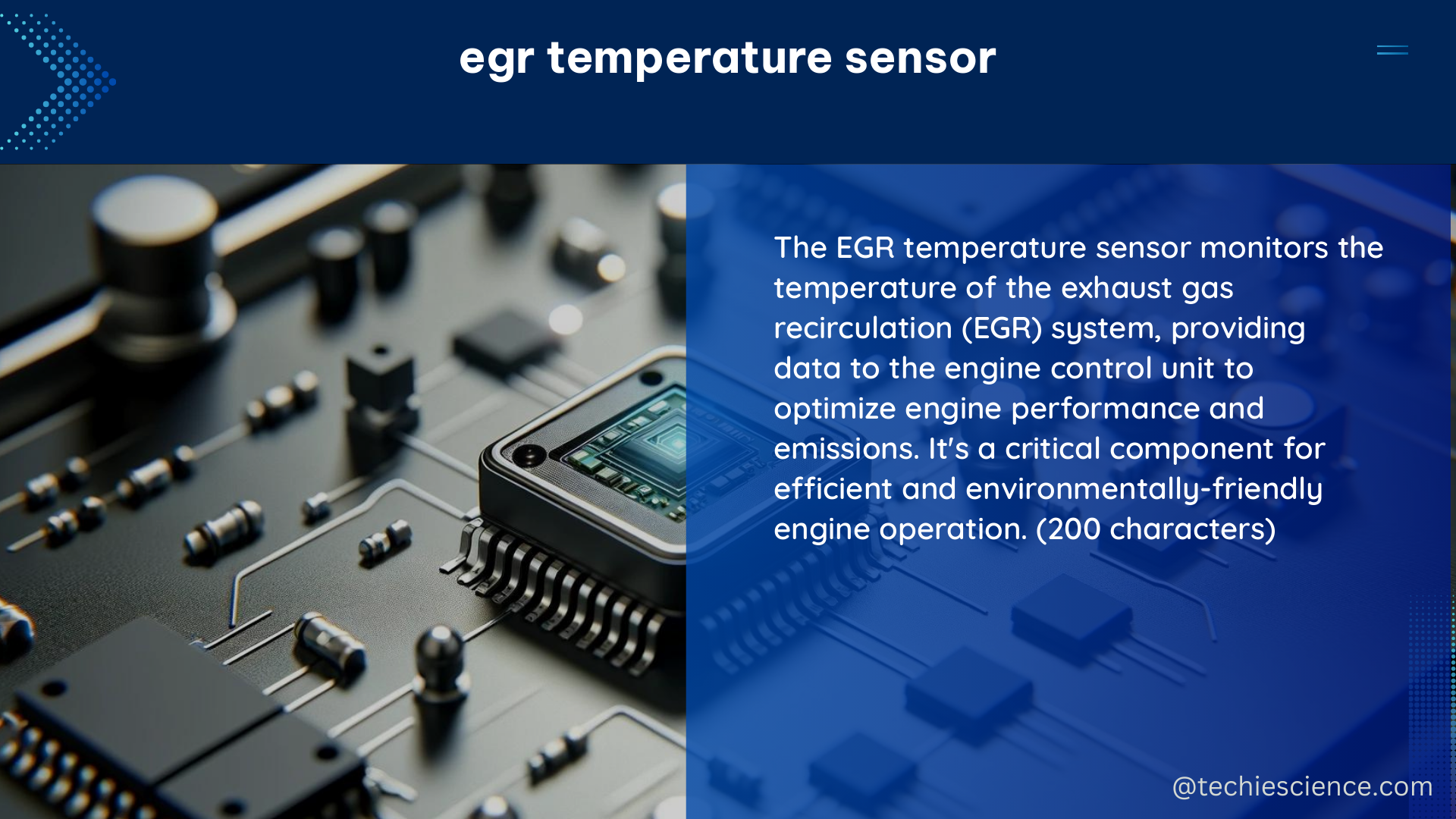The EGR (Exhaust Gas Recirculation) temperature sensor is a critical component in the EGR system, which plays a vital role in reducing nitrogen oxide (NOx) emissions in internal combustion engines. This sensor measures the temperature of the exhaust gases before they enter the EGR cooler, and the data it provides is used by the engine control module (ECM) to precisely control the EGR valve and maintain the optimal EGR rate.
Understanding the Technical Specifications of the EGR Temperature Sensor
The technical specifications of the EGR temperature sensor can vary depending on the specific engine and vehicle make and model. However, there are some common characteristics that are generally shared across different applications:
Sensor Type
The EGR temperature sensor is typically a thermistor, which is a type of resistor that changes its resistance in response to changes in temperature. The resistance of the thermistor decreases as the temperature increases, and this change in resistance is used to determine the temperature of the exhaust gases.
Resistance Range
The resistance range of the EGR temperature sensor can vary, but it is typically in the range of a few hundred ohms to a few thousand ohms, depending on the temperature range it is designed to measure. For example, a common resistance range for an EGR temperature sensor might be 300 ohms at room temperature (around 25°C) to 2,000 ohms at a maximum temperature of 800°C.
Temperature Range
The temperature range that the EGR temperature sensor is designed to measure can also vary, but it is typically in the range of 0°C to 800°C, or even higher in some applications. This wide temperature range is necessary to accurately measure the temperature of the exhaust gases, which can reach very high temperatures, especially in high-performance engines.
Sensor Accuracy
The accuracy of the EGR temperature sensor is also an important specification. Typical accuracy ranges can be in the order of ±5°C to ±10°C, depending on the sensor design and the specific application requirements.
Response Time
The response time of the EGR temperature sensor is another critical specification, as it determines how quickly the sensor can detect changes in exhaust gas temperature. Faster response times, typically in the range of 50 milliseconds to 200 milliseconds, are desirable to allow the ECM to make rapid adjustments to the EGR valve and maintain optimal EGR rates.
Sensor Construction
The physical construction of the EGR temperature sensor can also vary, but it typically consists of a thermistor element housed in a metal or ceramic casing that is designed to withstand the high temperatures and harsh environmental conditions of the exhaust system.
Diagnosing and Troubleshooting Issues with the EGR Temperature Sensor

Diagnosing and troubleshooting issues with the EGR temperature sensor can be a complex process, as it requires access to the sensor and its surrounding components, as well as the use of specialized diagnostic tools and techniques.
Sensor Location
The EGR temperature sensor is typically located in the exhaust manifold or near the EGR cooler, which can make it difficult to access in some vehicle models. In some cases, it may be necessary to remove other components, such as the intake manifold, to gain access to the sensor.
Sensor Testing
Once the EGR temperature sensor is accessible, it can be tested using a multimeter to measure its resistance at room temperature and at elevated temperatures. The resistance should decrease as the temperature increases, and any deviation from this pattern may indicate a faulty sensor.
Surrounding Sensor Considerations
In addition to the EGR temperature sensor, there are other sensors in the EGR system that can affect its performance, such as the oxygen sensors and the exhaust gas temperature sensors. These sensors provide feedback to the ECM, which uses this information to control the EGR valve and maintain the optimal EGR rate. Any issues with these sensors can also affect the performance of the EGR system and lead to increased emissions and reduced fuel efficiency.
Diagnostic Trouble Codes
When the EGR temperature sensor is not functioning properly, it can trigger diagnostic trouble codes (DTCs) in the vehicle’s on-board diagnostics (OBD) system. These DTCs can provide valuable information to help identify the root cause of the issue and guide the troubleshooting process.
Conclusion
The EGR temperature sensor is a critical component in the EGR system, which is essential for reducing NOx emissions in internal combustion engines. Understanding the technical specifications and troubleshooting techniques for this sensor is crucial for maintaining the optimal performance and efficiency of the EGR system.
By following the guidelines and best practices outlined in this comprehensive guide, you can effectively diagnose and address any issues related to the EGR temperature sensor, ensuring your vehicle’s emissions and fuel efficiency remain within acceptable limits.
References:
- Setting a best practice for determining the EGR rate in hydrogen internal combustion engines. ResearchGate, 2 Jan. 2023, www.researchgate.net/publication/257175539_Setting_a_best_practice_for_determining_the_EGR_rate_in_hydrogen_internal_combustion_engines.
- EGR Valve VS temperature sensors | Hyundai Forums. Hyundai Forums, 13 July 2013, www.hyundai-forums.com/threads/egr-valve-vs-temperature-sensors.163941/.
- Fast Spatially-Resolved EGR Distribution Measurements in an Operating Engine. ORNL Review, 2015, www.osti.gov/biblio/1326467.
- EGR Temperature Sensor function, California car. GalantVR4.org, 14 Mar. 2013, www.galantvr4.org/threads/egr-temperature-sensor-function-california-car.25140/.
- Bad EGR Temp Sensor symptoms? Maxima Forums, 7 Dec. 2012, maxima.org/forums/4th-generation-maxima-1995-1999/659036-bad-egr-temp-sensor-symptoms.html.

The lambdageeks.com Core SME Team is a group of experienced subject matter experts from diverse scientific and technical fields including Physics, Chemistry, Technology,Electronics & Electrical Engineering, Automotive, Mechanical Engineering. Our team collaborates to create high-quality, well-researched articles on a wide range of science and technology topics for the lambdageeks.com website.
All Our Senior SME are having more than 7 Years of experience in the respective fields . They are either Working Industry Professionals or assocaited With different Universities. Refer Our Authors Page to get to know About our Core SMEs.